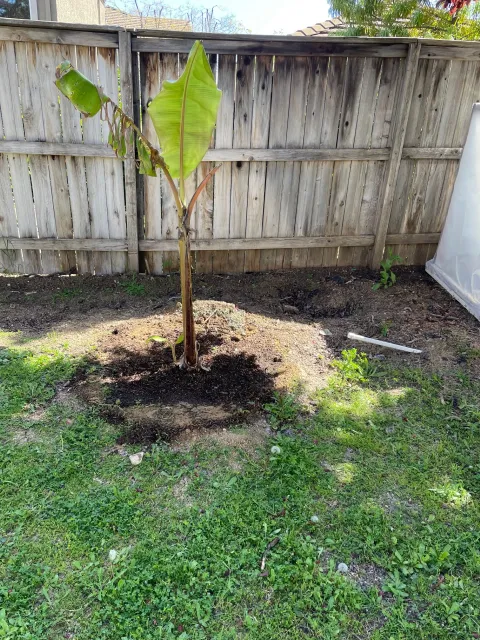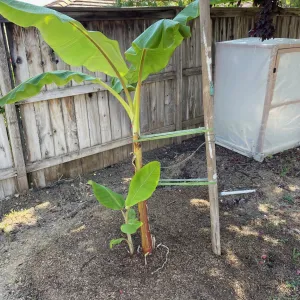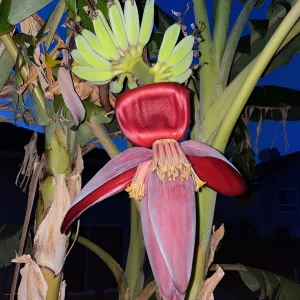Article by Vincent Hughes
Do you enjoy bananas? Have you ever thought that it would be a fun experience to grow your own bananas fresh at home? Have you been disappointed because the bananas you know and love are a tropical plant not suited to be grown natively here in Solano County? You CAN grow bananas here in Solano County!

When most people speak about bananas, they are referring to the Cavendish Banana (Musa acuminata) commonly sold in grocery stores, specifically the ‘Grand Nain’ (the “Chiquita banana”) cultivar. These bananas are tropical plants requiring very tropical conditions. To successfully raise a Cavendish banana, you will need warm temperatures between 75°F and 86°F (26°C to 30°C), six to eight hours of direct sunlight per day, protection from high winds, well-draining soil, and high humidity. The Cavendish banana can tolerate temperatures as low as 50°F (10°C), but growth begins to slow, and the plant itself begins to suffer from cold damage starting at 60°F (16°C). These factors make growing a Cavendish banana impractical if not impossible here in Solano County without having very specialized and controlled conditions to be able to raise it. This means that to grow bananas in our County, you will need to look past the tropical varieties and instead look at raising a cold-weather-tolerant species.
Allow me to introduce you to the Blue Java or Ice Cream Banana (Musa 'Blue Java'). A cold-weather-tolerant cultivar, this banana is a hybrid of Musa acuminata and Musa balbisiana. This banana is known for its sweet, aromatic fruit, which is said to have a consistency and flavor reminiscent of vanilla custard, as well as its sky-blue color. Able to be grown in USDA zones 8-11 outdoors, the Blue Java needs to have at least six hours of sunlight, and ideal temperatures of 75°F to 95°F. Unlike the Cavendish, however, the Blue Java can tolerate cold temperatures as low as 30°F (-1°C). Below that point, however, the plant will begin to be damaged by the frost. During the growing season, it is recommended to keep the Blue Java’s soil moist but not waterlogged, as it benefits from having moist but well-draining soil.
I began my personal journey in growing a Blue Java Banana natively in our soil in April of 2022. In looking to add more potassium to my diet and having previously heard of the Blue Java as having an ice cream-like flavor and consistency, I began to investigate where I could order the bananas to try some. Upon discovering that I could only buy them by the crate, and that a crate at that time cost the same amount as it would cost to purchase a tree, I decided that it would be a fun project to purchase and raise the tree for the fruit myself. Because of that, I ordered a tree which came in a five-gallon pot when it arrived at my home that May. Upon its arrival, however, I was still looking for a suitable location in my yard to plant it. This led me to acclimate the tree throughout that summer and autumn, and winter in its pot, allowing me to bring it inside if the conditions looked to be too far out of range.
In March of 2023, however, I settled upon a location and planted the tree along the south fence of my backyard. In this position, it received morning sun while being shielded from the afternoon sun by my nearby Japanese Plum. The position also helped to protect the young tree from the worst of the winds when they picked up. To further help the tree, when planting it, I filled the hole with a combination of native soil and nutrient-rich potting soil to help feed it. This, combined with regular watering, helped not only to fertilize the roots of the tree but to stimulate an intense growth pattern. In April of that year, my single tree produced a new sprout from its roots. By May, the new sprout was a quarter of the height of my original tree, with both shoots growing strong. And by June, a second sprout emerged from the soil, leaving me with not one, but three growing banana trees.

By the end of 2023, I had three rapidly growing banana trees and was hopeful that I would see bananas in the coming year. Having read that banana trees typically begin producing bananas in their second year, I was hoping that I would have fresh Blue Java bananas to try in 2024. But despite my hopes, I did not see any banana production. Instead, I watched as my three banana trees grew larger still. And in that, I watched a third banana sprout emerge, giving me a total of four banana trees. My singular Blue Java tree had begun to turn into a Blue Java grove. I continued to water and monitor the trees and their growth throughout the year.
Despite not receiving bananas in 2024, this year has proven to be the year of banana production. After three years of caring for and cultivating the original tree I had purchased, two large blossoms were produced from which the bananas have begun to emerge and develop. These began to emerge in April, and by June had begun to truly develop into bananas. And coupled with the emergence and development of the bananas, a new sprout has emerged from the roots as well to give me a fifth banana tree. While the bananas are still developing, they’ll soon be ready to harvest and eat.

In my research leading up to planting, I had read that it typically takes between fifteen and twenty-four months, or about one to two growing seasons, for the Blue Java to begin producing bananas. My research also revealed that from the emergence of the banana blossoms to the point of harvest is between three and five months, depending on your local conditions. I look forward to finding out exactly what my local conditions will lead to.
So, if you would like to try growing your own bananas here in Solano County, be sure to keep the following in mind:
- Plant a species that is cold-weather tolerant to be able to withstand the low winter temperatures of our County. If a prolonged cold front lower than the trees’ tolerance is coming in, be ready to provide a form of protection to the tree to prevent cold damage. If planted in the ground, wrap the trunk of the tree with burlap, and if possible, use a space heater to warm the base of the tree. If the tree is in a pot, you can move it to a warmer location.
- Be sure that the area you are planting in has space for your tree to grow. They can rapidly grow to a height of ten to fifteen feet while also putting off additional sprouts.
- Be sure that the soil you are planting in is well-draining, as waterlogged soil can lead to root rot.
- Be patient. Online resources cite that it can take one to two growing seasons for food production to begin, but it can take longer depending on your local conditions.
If you can follow those four steps, you can successfully grow your own bananas in your backyard. It is a process that, while long, is very rewarding. So, until next time, good luck, and happy growing!

